As part of our recently-released Bordeaux study, Wine Lister asked its Founding Members (c.50 key members of the global fine wine trade) to give “confidence” ratings to more than 100 key Bordeaux wines on a scale of 0 to 10; 0 being zero confidence.
For the second year in a row, no wine received a perfect 10/10, unlike Burgundy, whose Domaine de la Romanée-Conti and Rousseau – as rated across all of their respective cuvées – achieved the perfect score in a survey carried out in Autumn 2017.
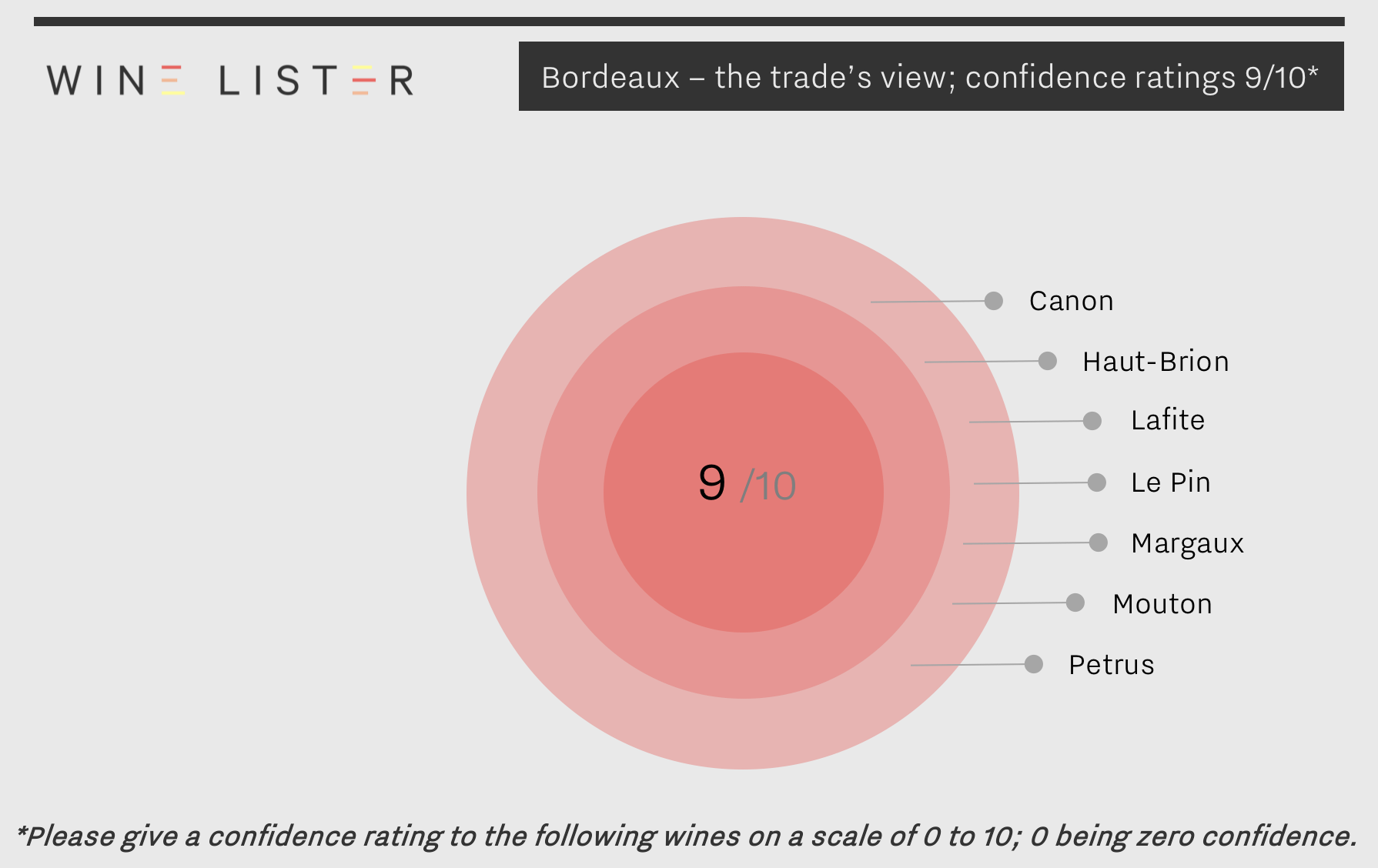
Seven wines received a confidence rating of 9/10 from the trade; Canon, Haut-Brion, Lafite, Le Pin, Margaux, Mouton & Petrus. These same seven were awarded 9/10 in last year’s founding members’ survey. Vieux Château Certan is the only château to have dropped down a spot to 8/10.
Canon’s place here is distinctive not just as the only Saint-Émilion to feature, but also as a wine with market prices around £74 per bottle, sitting amongst a group whose average price per bottle is £950. A Wine Lister Buzz Brand, Canon is one of the most talked about wines by the trade.
In carrying out the survey, we did not dictate what factors should influence the respondents’ confidence in the prospects of a wine. Given that they are members of the trade, their considerations are likely to be commercially-driven, taking into account everything from improvements in quality and investment in marketing to new management teams. Canon was deemed a success by trade members for both “ratings and quality improvement”, and its “sales and management team”.
Latour is the only first growth not to feature in the highest-rated group. It was given a confidence rating of 8/10, alongside 20 other wines shown below. Three of these, Pichon Comtesse, Calon Ségur and Rauzan-Ségla (alongside its abovementioned sibling from owners Chanel, Canon) also make the trade’s list of Rising Stars – wines that will see the largest gain in brand recognition in the next two years (more on Bordeaux’s Rising Stars to come next week).
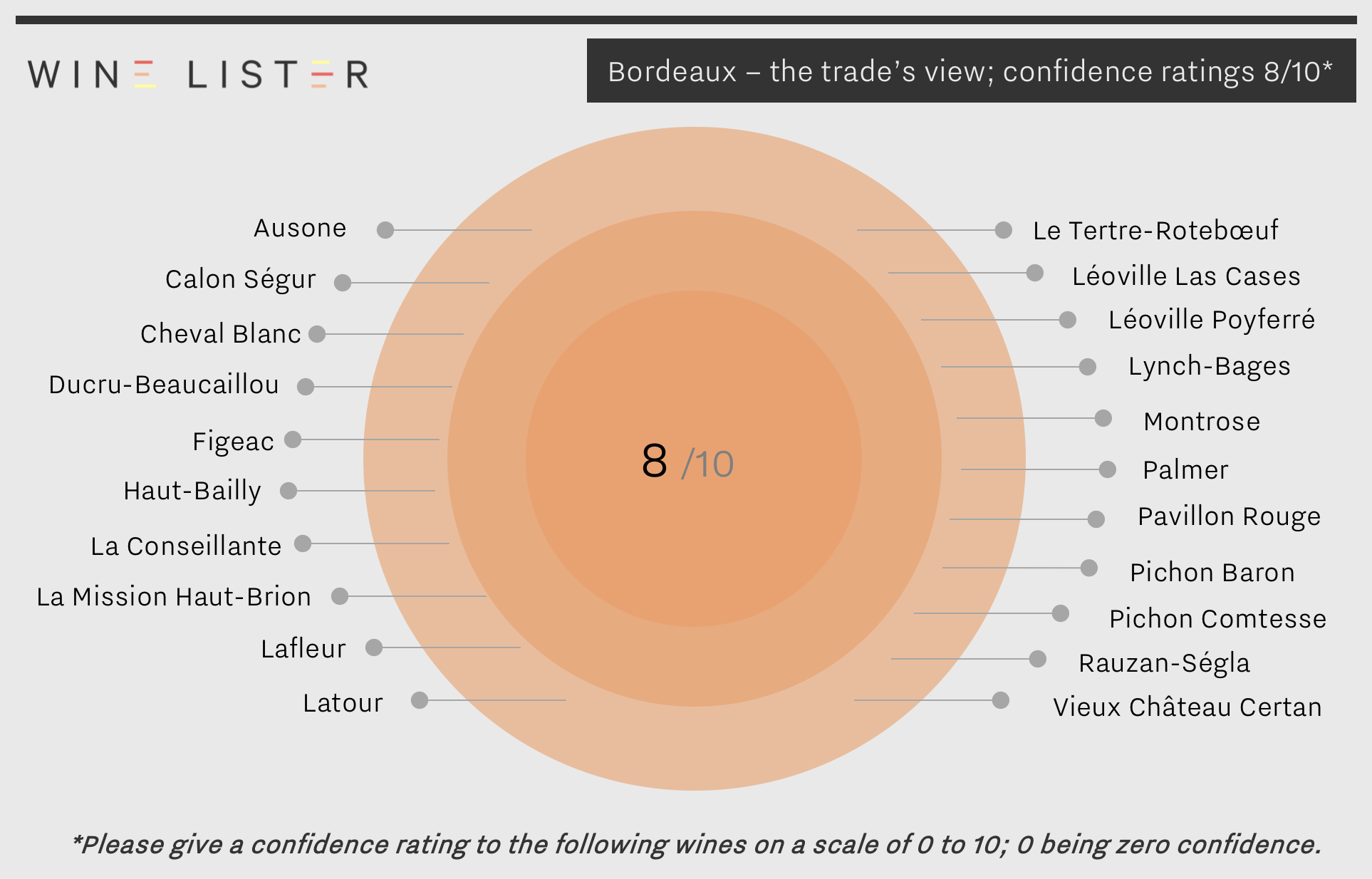
Nine wines have dropped one point in 2018 to a confidence rating of 7/10, however these have been replaced in equal number by Cheval Blanc, Figeac, La Conseillante, Tertre-Rotebœuf, Léoville Las Cases, Pavillon Rouge, Montrose, Palmer, and Pichon Baron, all up one point from their ratings in 2017.
Other wines to receive a confidence rating of 8/10 from the international fine wine trade are Ausone, Ducru-Beaucaillou, Haut-Bailly, La Mission Haut-Brion, Lafleur, and Lynch-Bages.
Visit Wine Lister’s Analysis page to read the full report and see confidence ratings for other wines in the study (available in both English and French).
Taking inspiration and occasionally investment from Bordeaux’s most prestigious châteaux, Chile’s leading producers have, over a relatively short timeframe, become serious contenders in the fine wine market. Having had the opportunity to carefully select their sites, and benefitting from a more consistent climate than their Old World counterparts, Chile’s foremost wines continue to go from strength to strength. This week, we consider the overall top-scoring wines from the long sliver of land that has the cool Pacific on one side and the vertiginous Andes on the other.
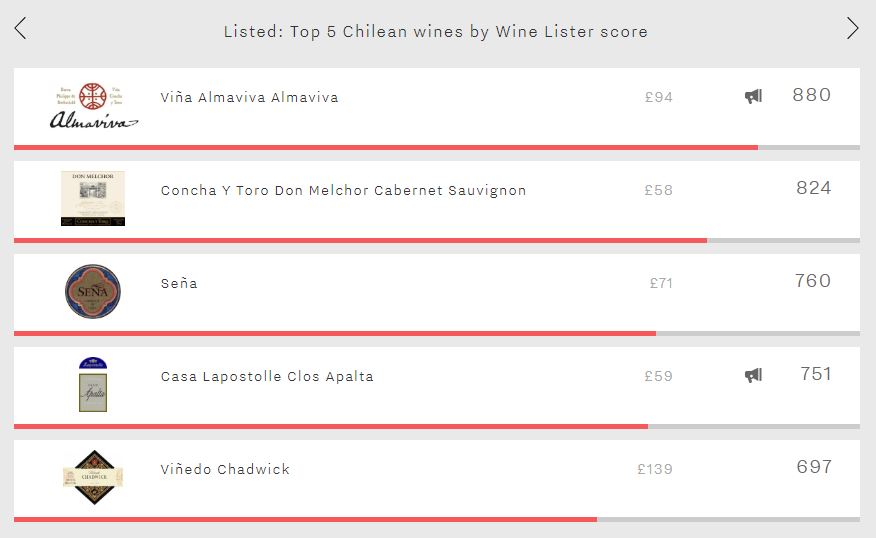
Leading the way is Almaviva (880). One of two Chilean Buzz Brands, this joint project between Baron Philippe de Rothschild and Concha y Toro achieves Chile’s strongest Brand score (917), the result of not only featuring in more of the world’s top restaurants but also being twice as popular as any other Chilean wine. Surely Almaviva’s association with Mouton has played a significant role in its ability to build its brand to such a level over a short period of time – its first vintage was in 1998. It also manages Chile’s highest Economics score (787) – still ranking it within the “very strong” segment of Wine Lister’s 1,000-point scale, but indicating that it is the area in which Chilean wines currently struggle to compete with their Old World counterparts.
Further proof that economic success is the department in which Chile’s best wines have the most room to improve, Chadwick achieves the country’s best Quality score (904), yet only manages a score of 295 in the Economics category. This modest score is due to a combination of negative price performance over the past six months and a failure to trade a single bottle at auction over the past year, resulting in Chadwick slipping down to fifth place overall (697).
Don Melchor is Chile’s second-best wine (824) – completing a one-two for the Concha y Toro stable. It earns its second place thanks to consistency across each of Wine Lister’s three rating categories, finishing third in the Quality and Brand categories (872 and 853 respectively), and achieving Chile’s second-best Economics score (662). It is, however, considered Chile’s most ageworthy wine, with an average predicted drinking window of 11 years, 30% longer than any other Chilean wine.
The two remaining spots are filled by Seña – the second wine from the Errazuriz stable (alongside Chadwick) – and Casa Lapostolle Clos Apalta, with scores of 760 and 751 respectively. They present contrasting profiles, Clos Apalta achieving a better Quality score (829 vs 811) and Brand score (872 vs 770), but experiencing a significantly lower Economics score (364 vs 626).
En primeur pricing is a crucial factor in the commercial success of top Bordeaux crus. With this in mind, Wine Lister has dedicated a section of this year’s Bordeaux study to the conundrum. We show historical pricing trends post release for a panel of 76 wines. The analysis indicates the effectiveness of release prices, based on the change between average ex-négociant release and current market prices (2009-2016 vintages):
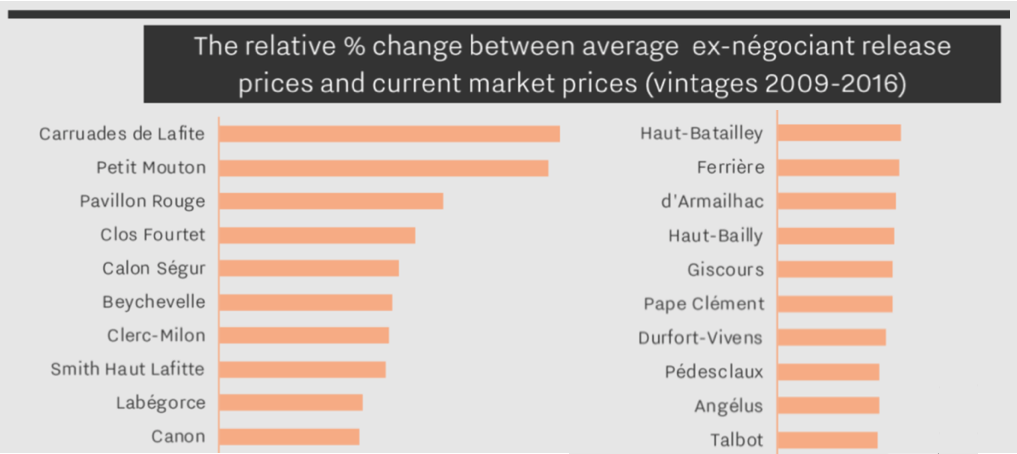
Above are the top 20 best-performing Bordeaux wines post en primeur release (to view the performance of all 76 wines, see page 14 of the Bordeaux study). The second wines of Lafite and Mouton have enjoyed the greatest gains in the marketplace, with Pavillon Rouge not far behind in third place.
Clos Fourtet is the best of the rest, followed by Calon Ségur, Beychevelle, Clerc-Milon and Smith Haut Lafitte. Lafite is the best-performing first growth, followed by Margaux and Mouton, with Haut-Brion making smaller gains.
This year’s en primeur campaign has not yet been met by the same enthusiasm as the 2016 or 2015 vintages. The average quality of 2017 is lower (by 10% if we take Wine Lister Quality scores for the same 76 wines) – a major factor in explaining price sensitivity, and why the average discount so far of 7% (9% excluding Haut-Batailley’s contrary price hike) is far from sufficient to oil the wheels of the campaign.
In our Bordeaux Market Study 2018, released just last week, we clarify an illustrative methodology for calculating release prices. Wine Lister looks at current market prices for similar recent vintages, and works backwards through three steps:
- Vintage comparison: As there is no obvious comparison for 2017, we apply the average quality to price ratio of the last nine vintages in order to arrive at a derived future market price, based on the average Wine Lister Quality score.
- Ex-château price: By removing the margins taken by the négociant and importer we reach the equivalent ex-château price.
- En primeur discount: Finally, we apply a discount of 10%-20% to incentivise buying en primeur, rather than waiting until the wine is physically available.
The chart below shows the theoretical application of this methodology to a basket of top wines. See page 13 of the Bordeaux study for a more detailed explanation.
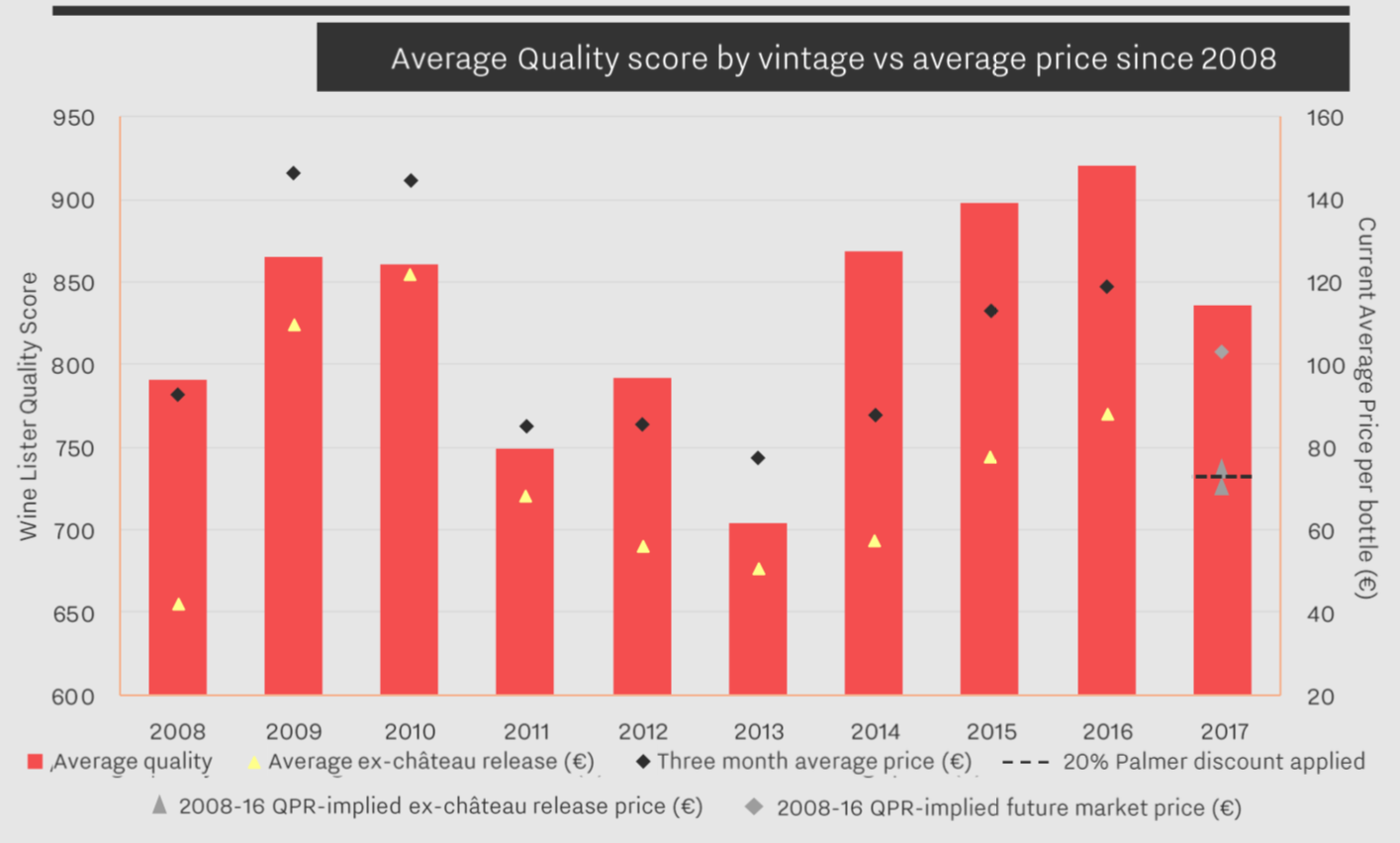
Prices released in the campaign thus far have varied from 20% discounts (Palmer, Domaine de Chevalier Rouge) to a 46% increase (Haut-Batailley) on last release prices.
Follow Wine Lister on Twitter for realtime en primeur release information, and use our dedicated en primeur page to compare 2017 release prices to last year.
Other wines featured in the top 20 best-performing Bordeaux post en primeur release are: Labégorce, Canon, Haut-Batailley, Ferrière, d’Armailhac, Haut-Bailly, Giscours, Pape Clément, Durfort-Vivens, Pedesclaux, Angélus, and Talbot.
Subscribers can download a copy of the full Bordeaux Study 2018 from the analysis page.
As we outlined in our introduction to the vintage, Bordeaux 2017 eludes generalisation. Striking arbitrarily, the late April frost resulted in a heterogenous Bordeaux vintage in terms of both volumes and quality.
Ahead of the official release of Wine Lister’s latest Bordeaux Market Study tomorrow (don’t forget to subscribe to secure full access, via the Analysis page)*, here we give you a preview of the top 20 Quality scores for Bordeaux 2017. Wine Lister’s Quality scores for Bordeaux 2017 are based on the recently-released scores for four of our five partner critics** – Jancis Robinson, Bettane+Desseauve, and Vinous’ Antonio Galloni and Neal Martin – as well as a small weighting for longevity:
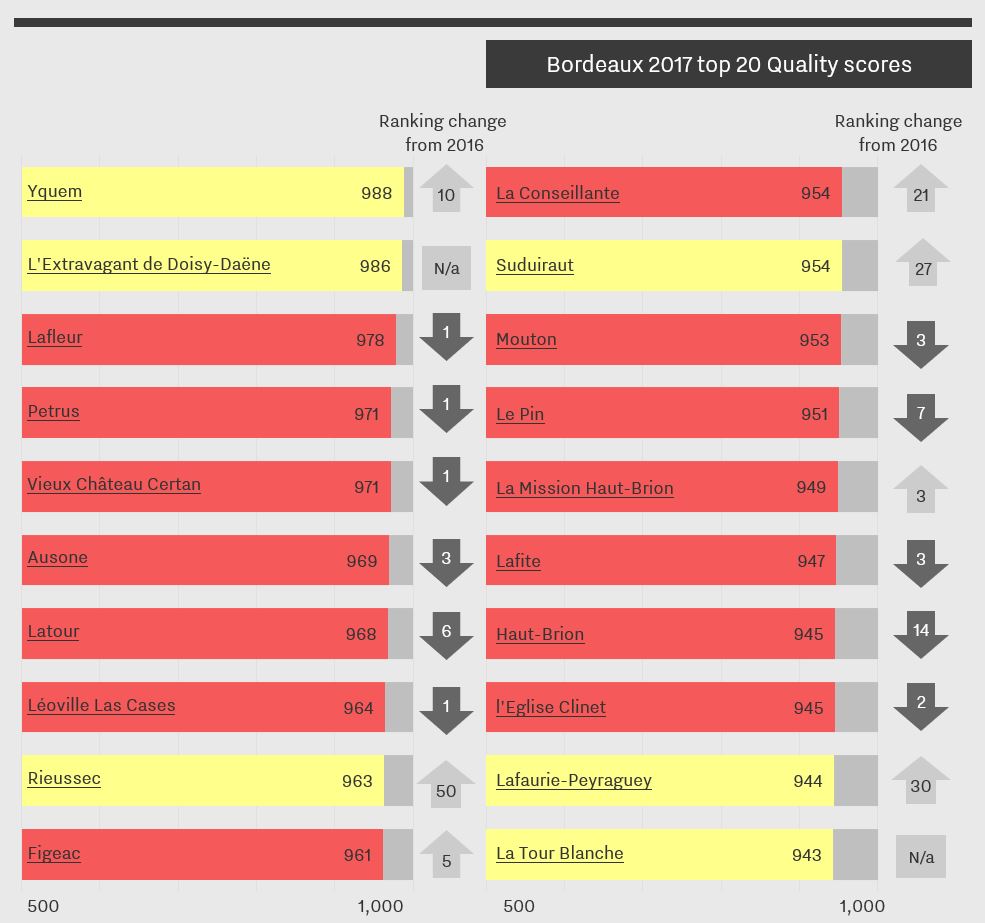
The frequent flashes of yellow in the chart above are testament to the kindness of the 2017 vintage to Bordeaux’s sweet whites, with Yquem and L’Extravagant de Doisy-Daëne achieving first and second places (scoring 988 and 986 respectively). Other sweet wines, Rieussec, Suduiraut, and Lafaurie-Peyraguey make some of the largest gains on their 2016 positions. Sauternes & Barsac stand out as the only appellations whose combined 2017 Quality score is above that of the 2016 (up 21 points).
When it comes to reds, the right bank fares best, and is home to seven of the vintage’s top 10 wines, five of them from Pomerol. Lafleur is the top-scoring red (in third place overall) with a Quality score of 978, followed by Petrus and Vieux Château Certan on 971 apiece. Pomerol’s La Conseillante makes the largest strides of any red wine in the top 20, up 21 places since 2016.
Overall, Pomerol is the highest-scoring appellation of the vintage, with an average Quality score of 959 (nonetheless down 25 points from 2016).
The left bank has fared less well with two of the five left bank appellations seeing score decreases of c.10% (Margaux and Saint-Estèphe, achieving 850 and 829 respectively). Despite dropping six places – from the top spot last year – Latour wins the left bank crown, followed by consistent overperformer Léoville Las Cases.
Other wines featuring in the top 20 Bordeaux 2017 Quality scores are: Ausone, Figeac, Mouton, Le Pin, La Mission Haut-Brion, Lafite, Haut-Brion, l’Eglise Clinet, and La Tour Blanche. You can view Quality scores for wines outside the top 20 here.
*Now published: for more analysis of the 2017 vintage, subscribe to read our Bordeaux Study.
**Jeannie Cho Lee was unfortunately unable to travel to Bordeaux to taste this year.
While the wine world lives and breathes Bordeaux during this year’s en primeur season, Wine Lister looks at some high-scoring Bordeaux reds that could easily be overlooked amidst the sea of releases to choose from across Médoc classified growths and beyond. Below we examine the top five fourth growths by overall Wine Lister score.
The highest-scoring Bordeaux fourth growth on Wine Lister is Château Beychevelle, with a score of 879. Its trailing Quality score of 790 is boosted by Brand and Economics scores of 980 and 904 respectively. Meanwhile, Beychevelle’s 2016 and 2015 vintages achieve Quality scores more than 15% higher than its wine-level average. It will be interesting to see how the 2017 vintage (with a Quality score of 805 thus far, based on partner critics Bettane+Desseauve, Neal Martin and Julia Harding MW for Jancis Robinson) is priced during this year’s en primeur campaign in the coming weeks.

In second and third place are Château Talbot and Château Branaire-Ducru, achieving Wine Lister scores of 859 and 842 respectively. Talbot is the most popular of the five, receiving 14,602 searches each month on Wine-Searcher, resulting in the group’s best Brand score (983). Talbot’s position as a ubiquitous Bordeaux brand is no doubt helped by a production level of c.400,000 bottles per annum – over twice as many as Branaire-Ducru.
The fourth entry and only Pauillac to feature, Duhart-Milon, has the lowest Quality score of the five (752), but carries a Brand score of 916 points. It is no surprise that, as part of the Lafite group, it is the most-traded Bordeaux fourth growth at auction, its top five vintages having traded 1,186 bottles over the past four quarters.
Finally, Lafon-Rochet appears in the Listed blog for the second week in a row (previously featuring in the top five Saint-Estèphes by Economics score). At 800 exactly, Lafon-Rochet’s Wine Lister score is safely in the “very strong” category on the 1,000-point scale. In the context of this week’s top five it has the third-highest Quality score (770), but its price per bottle is 41% below the rest – a savvy buy!
Bordeaux 2017 en primeur scores are now out from Neal Martin for Vinous.com – our US partner critic, and one of the most prominent voices of international wine criticism today. (Antonio Galloni’s scores are due out this Thursday, 3rd May). This is the first time Wine Lister has featured Neal Martin’s scores after he joined Vinous in February this year. Below are his scores equal to or above 94-96:
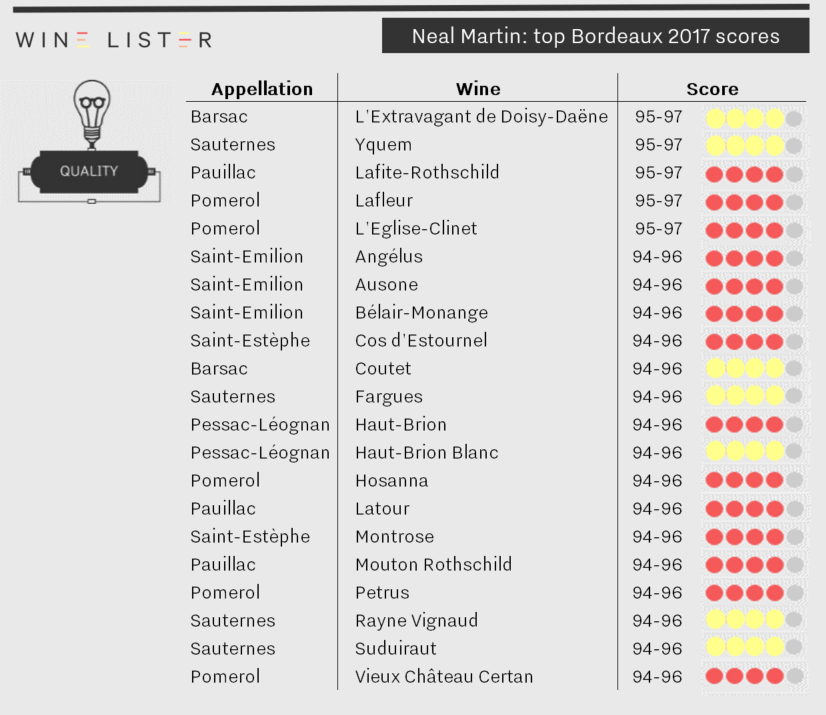
No wines earned perfect scores this year (in contrast with 2016, where Martin awarded a potential 100 points to eight wines), with five wines achieving Martin’s highest potential score of 97.
With a score of 95-97, Yquem sits in the top score bracket for the third time, already awarded 18.5 and 19.5-20 by Julia Harding MW (on behalf of Jancis Robinson) and Bettane+Desseauve respectively.
Similarly to Bettane+Desseauve, Martin’s appreciation for the quality of Sauternes and Barsac in 2017 is clear, with five other sweet whites making his top 21 (L’Extravagant de Doisy-Daëne, Coutet, de Fargues, Rayne Vignaud, and Suduiraut).
Lafite is Martin’s highest scoring Médoc first growth, which he describes as “classic from start to finish”. Joining the high rankings are first growths Haut-Brion (and its white), Latour, and Mouton, all earning 94-96 points.
The right bank figures strongly too. Two Pomerols (Lafleur and L’Eglise-Clinet) equal Lafite’s score, with three more earning 94-96, alongside three wines from Saint-Emilion. Ausone, like Yquem, makes its third appearance in top scores for Bordeaux 2017 from Wine Lister partner critics. “What a great Ausone this is destined to be,” comments Martin.
Bélair-Monange is perhaps the stand-out entry, described by Martin as, “the jewel in the crown of J-P Moueix… an assured, and bewitching Saint-Emilion”.
Other wines scoring 94-96 from Neal Martin include: Angélus, Cos d’Estournel, Hosanna, Montrose, Petrus, and Vieux Château Certan.
All these scores are now live on the wine pages of our website for subscribers to view (alongside those of Bettane+Desseauve and Julia Harding), with links through to Neal Martin’s tasting notes on Vinous.com. Read Neal Martin’s coverage of Bordeaux 2017 here.
Vinous coverage will be completed by Antonio Galloni’s scores, due for release on Thursday 3rd May.
Bettane+Desseauve – Wine Lister’s French partner critics – have released their en primeur scores for the 2017 Bordeaux vintage. Here is a glimpse of their top-scoring wines:
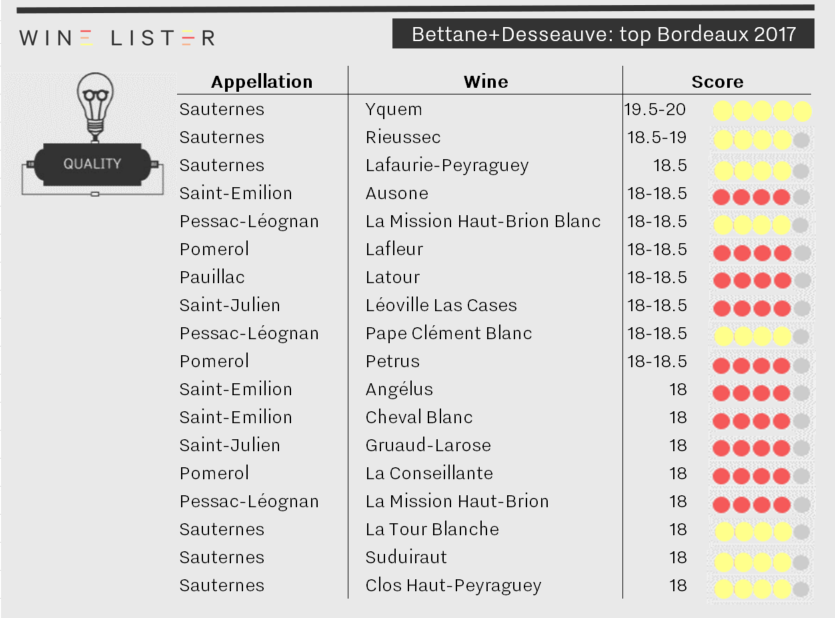
Château d’Yquem is the only potentially perfect wine of the vintage for the French duo. “Another legend ending in 7, worthy of the 1967, but more pure, and the sublime 1937 and 1947 too,” muses the encyclopaedic Michel Bettane.
Yquem was the only white wine to make an appearance in Bettane+Desseauve’s top 2016 Bordeaux, but this year has been joined by a host of other Sauternes (Rieussec, Lafaurie-Peyraguey, La Tour Blanche, Suduiraut, and Clos Haut-Peyraguey), in a vintage which Bettane has marked out as “favourable for the entire Haut-Sauternes sector”.
Two dry whites also broke the 18-point mark: La Mission Haut-Brion Blanc and Pape-Clément Blanc, painting the top of the scoreboard unprecedentedly yellow.
As for reds, taking more of a backseat than usual, the right bank dominates, with three out of the four Saint-Emilion Grands Crus Classés A scoring 18 (Angélus and Cheval Blanc) or above (Ausone). By contrast only one Médoc first growth – Latour – reaches the 18-point mark.
Joining Ausone and Latour with 18-18.5 are Lafleur, Léoville Las Cases, and Petrus. Our CEO, Ella, tasted Petrus twice – first for a sneak preview with Thierry Desseauve and her father, and then with the Wine Lister team three days later. She is not surprised to see it come out among the top five reds of the vintage, and it must run in the family, because Petrus was also Pa Lister’s favourite.
Bettane+Desseauve’s top table sees standout scores of 18 apiece granted to La Conseillante and Gruaud-Larose. And that in a year where fewer high scores were given in general; 16 2016s scored a straight 19 or above last year, compared to just one in 2017.
“Buzz Brands” is one of the four Wine Lister Indicators developed to help our users identify wines for different scenarios. A Buzz Brand is a wine with strong distribution in the world’s top restaurants, enjoying high levels of online search frequency or demonstrating a recent growth in popularity, and identified by the fine wine trade as trending or especially prestigious. As such, you wouldn’t expect them to come cheap, and the five most expensive dry whites definitely don’t, costing around £2,000 on average.
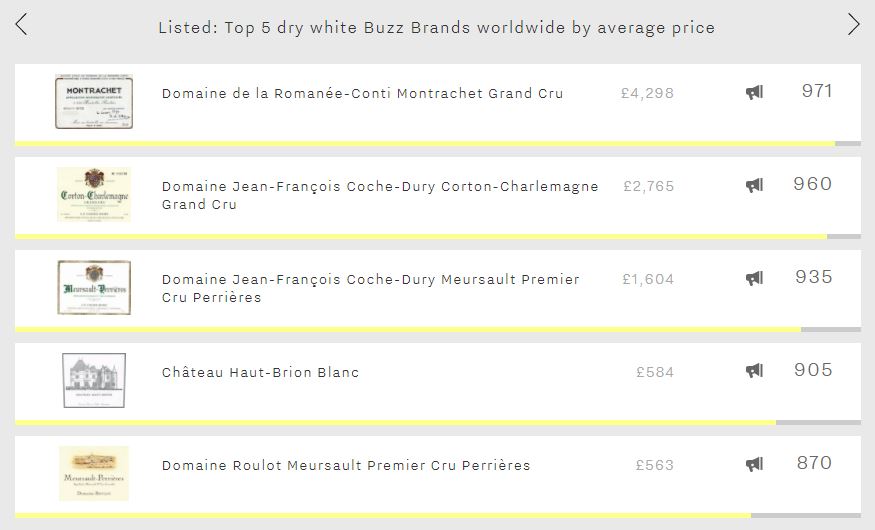
Perhaps unsurprisingly given the miniscule production of its top wines, Burgundy fills four of the five spots (and two of these are from Coche-Dury). DRC Montrachet is the world’s second-most expensive dry white – behind Leflaive’s Montrachet which fails to achieve Buzz Brand status. It achieves the best Quality score of this week’s top five (976), just pipping Coche-Dury’s Corton-Charlemagne to the post (971). It also enjoys the highest Brand score of the group – or any dry white for that matter (960) – the result of appearing in considerably more of the word’s top restaurants than Coche-Dury’s Corton-Charlemagne, which comes second in that criterion (26% vs 19%), and also being nearly 50% more popular than any of the rest of the five.
Whilst Coche-Dury’s Corton-Charlemagne has to settle for second place in the Quality and Brand categories, it not only manages the group’s top Economics score (991), but also the highest of any dry white on Wine Lister. This is thanks to formidable price growth. It has recorded a three-year compound annual growth rate (CAGR) of 25%, and has added 14% to its price over the last six months alone.
It is to be expected that wines from two of Burgundy’s most hallowed grand cru vineyards command the group’s highest prices, but it might come as more of a surprise that two Meursaults from the premier cru Perrières vineyard feature. With over £1,000 separating the considerably more expensive offering from Coche-Dury and Roulot’s expression, it becomes clear that Brand score is a significant driver of price at this rarefied end of the scale, particularly within Burgundy.
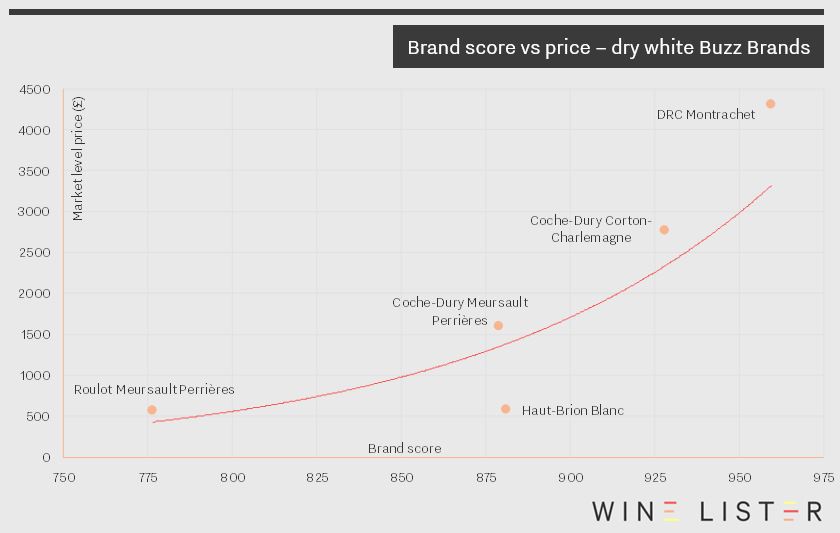
Proving that expensive Buzz Brands are not only to be found in Burgundy, Haut-Brion Blanc makes an appearance in the top five. Whilst it is the most liquid of the group – its top five traded vintages have traded 49% more bottles than any other wine in the five – it has experienced by far the lowest growth rates, with a three-year CAGR of 9% compared to the Burgundy quartet’s remarkable average of 22%.
Whilst the wine world – including much of Wine Lister’s team – focuses its attention on Bordeaux for en primeur tastings, this week the blog hops over the pond to consider Oregon’s top wines. As might be expected, Oregon’s top five wines are all Pinot Noirs. Furthermore, in this relatively young fine wine region, its leading wines perform best in the Quality category (averaging 791), with their brand profiles and economic performance not yet able to keep pace (554 and 363 points respectively on average).
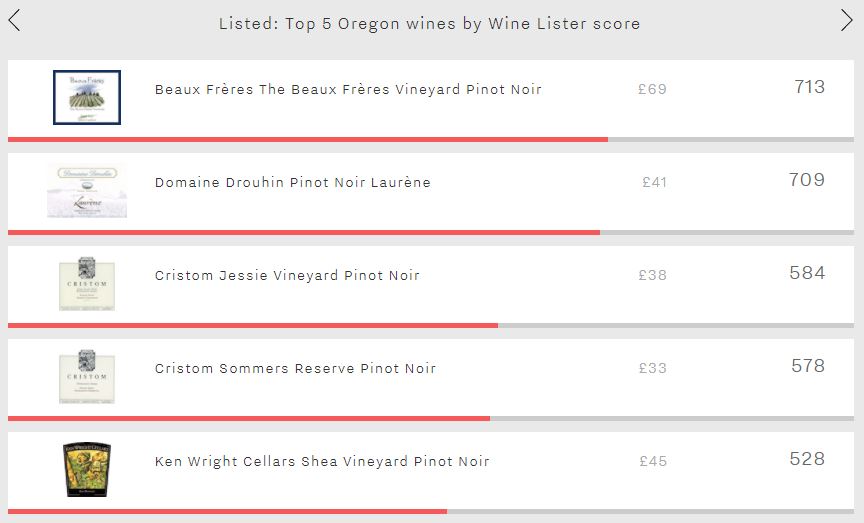
Whilst quality is king in Oregon, Beaux Frères Vineyard tops the table not because of its Quality score (785) – the third-best of the five – but for its stronger brand recognition. It leads Drouhin Laurène – second in the Brand category – by 113 points (715 vs 602), thanks to superior restaurant presence (9% vs 4%) and also because it receives 40% more searches on Wine-Searcher each month on average. Its Economics score of 545 is also Oregon’s strongest, but with low trading volumes and negative price growth over the past six months, this only puts it in the “average” range on Wine Lister’s 1,000 point scale, confirming that it is the area in which the region’s wines currently struggle.
Drouhin’s Laurène achieves the group’s highest Quality score (872). Produced by the Oregon offshoot of Burgundy’s Maison Joseph Drouhin, this is deemed to have the greatest ageing potential of the five, with an average drinking window of nine years, three years longer than the second-longest lived of the group – the Beaux Frères Vineyard.
Third and fourth spots are occupied by two wines from Cristom – Jessie Vineyard (584) and Sommers Reserve (578). Despite being separated by just six points at overall Wine Lister level, they display contrasting profiles. While the Jessie Vineyard achieves a superior Quality score (858 vs 770) and Brand score (490 vs 439), the Sommers Reserve nudges ahead in the Economics category (389 vs 133). This is thanks to it being the only wine of the group whose price has not dipped slightly over the past six months, instead adding 12% to its value.
The final wine of the group – Ken Wright Cellars Shea Vineyard – epitomises the profile of Oregon’s top wines, achieving its best score in the Quality category (670), a weaker Brand score (522), before experiencing its lowest score in the Economics category (220). Perhaps as Oregon continues to establish itself on the international fine wine market – and with its quality not in doubt – its leading wines will be able to build up stronger brands and economic profiles able to rival their more southerly Californian peers.
With its top ten wines by Quality score costing £225 per bottle on average, Piedmont might seem overindulgent for a low key midweek meal. However, with a little bit of help in the shape of Wine Lister’s Value Pick search tool, it is easy to find wines that will deliver maximum enjoyment at reasonable prices. Value Picks represent the very best quality-to-price ratio wines, with a higher coefficient applied to allow exceptional quality to be recognised. With a remarkable average Quality score of 976, and costing £40 on average, these five Piedmontese wines prove that outstanding quality is available at all price points.
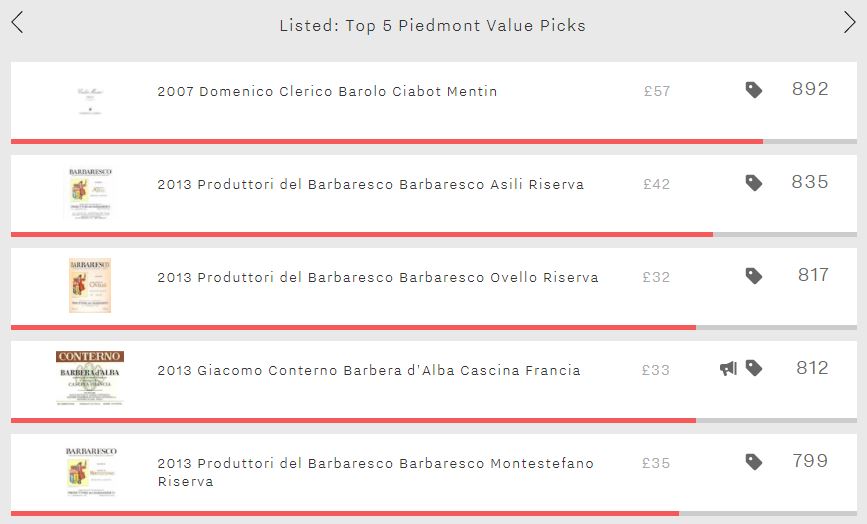
If you’re after top Nebbiolo at a fair price, then Produttori del Barbaresco’s 2013s appear a safe bet, filling three spots. However, the trade-off for top value will be patience – none of the three will enter its drinking window until 2023. However, with each of them lasting over 18 years, you will be able to make the most of your prudent purchases for years to come. And what better way to explore Barbaresco’s crus in an outstanding vintage than with these three? The Asili Riserva achieves the top Quality score of the three (987), 75 points above its wine-level average. It is also the most expensive, but £42 per bottle doesn’t seem unreasonable for such quality. The Montestefano Riserva really outperformed in the 2013 vintage with a Quality score of 972, 125 points above its average score. The market is yet to react – the 2013’s price is currently 16% below its wine-level average.
Proving that if you’re looking for value for money in Piedmont, it’s not just Barbaresco that you should look out for, Domenico Clerico Barolo Ciabot Mentin 2007 is the region’s number one Value Pick. With a Quality score of 989 – thanks to a 98 point score from Antonio Galloni – it is not hard to see why. What’s more, whereas the Produttori del Barbaresco 2013s require cellaring, the Ciabot Mentin is just entering its drinking window.
Showing that Piedmont is not all about Nebbiolo, Giacomo Conterno’s Barbera d’Alba Cascina Francia 2013 fills the remaining spot. The group’s only Buzz Brand, this would be an excellent way to sample one of Giacomo Conterno’s wines at a fraction of the cost of the domaine’s top cuvées – the hallowed Monfortino Riserva costs £608 per bottle on average.
Prices per bottle are provided by our price partner, Wine Owners, whose own proprietary algorithms process millions of rows of incoming price data from Wine-Searcher to calculate a more realistic market level price – the price at which a wine is likely to find a ready buyer – based on market supply and spread models. As lower retail prices are likely to sell first, the prices you see on Wine Lister may be below the Wine-Searcher average in some instances.












